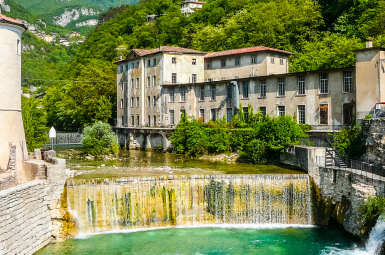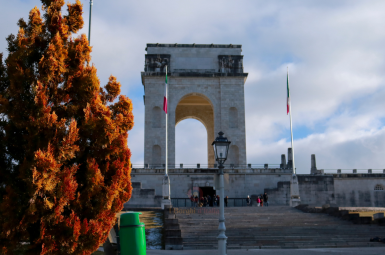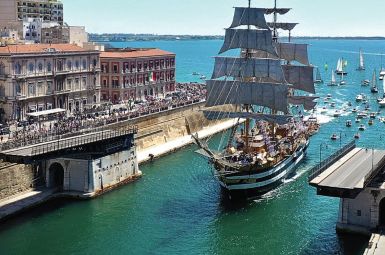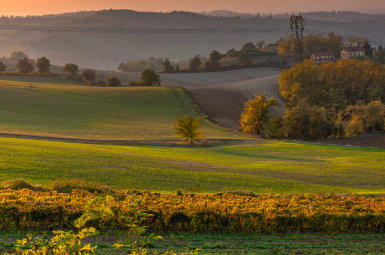
Il Borgo di Scilla
Scilla: Dove il Mito Diventa Paesaggio e il Mare Incontra la Storia
Scilla non è semplicemente una meta turistica: è un’icona, l’approdo obbligato dove la Calabria si tuffa nello Stretto, tessendo un legame eterno tra la mitologia omerica e l’incanto di un borgo marinaro. Incastonata nel cuore della Costa Viola, Scilla offre un’esperienza sensoriale in cui il colore cangiante del mare si fonde con la storia millenaria della rocca.Chianalea: La “Piccola Venezia del Sud”
Il cuore pulsante e l’anima più fotografata di Scilla è il borgo di Chianalea, universalmente noto come la “Piccola Venezia del Sud”.- Case Sull’Acqua: Questo pittoresco quartiere di pescatori è un gioiello architettonico unico. Le case, addossate le une alle altre, sembrano sorgere direttamente dagli scogli, bagnate dalle onde. I loro vicoli stretti, spesso interrotti da brevi scalinate, si aprono su canali che lambiscono le fondamenta, dove le barche, tipiche imbarcazioni per la pesca del pescespada, riposano a pochi centimetri dall’uscio di casa.
- Vita di Mare Autentica: A Chianalea si respira l’autentica tradizione marinara. È qui che si incrociano le voci dei pescatori, l’odore della salsedine e l’eco delle antiche battute di pesca, un’atmosfera sospesa nel tempo, riconosciuta come uno dei Borghi più Belli d’Italia.
Il Castello dei Ruffo: La Sentinella del Mito
A dominare il promontorio roccioso che divide Chianalea dalla Marina Grande si erge, maestoso e imponente, il Castello dei Ruffo di Calabria.- Storia Stratificata: La sua fondazione risale probabilmente all’epoca dei Greci o dei Bizantini, ma fu rafforzato dai Normanni e divenne la sontuosa residenza fortificata dei Ruffo, potente famiglia calabrese. Oggi ospita eventi culturali e offre un punto di osservazione privilegiato.
- Belvedere Incomparabile: Dalle sue mura, la vista spazia in un panorama mozzafiato che abbraccia le Isole Eolie, la costa siciliana e le acque azzurre dello Stretto. Il Castello è la materializzazione della rupe che, secondo il mito, ospitava il terribile mostro Scilla.
Il Fascino della Leggenda: Scilla e Cariddi
Il nome stesso della città evoca immediatamente l’epica classica. Scilla è il punto geografico fissato da Omero nell’Odissea come una delle due fauci mortali che attanagliavano lo Stretto.- Il Mostro e l’Eroe: La leggenda narra della bellissima ninfa Scilla, trasformata in un orrendo mostro marino da Circe (per gelosia dell’amore di Glauco), che si annidava nella rupe per ghermire i naviganti. Insieme al vortice di Cariddi, sulla sponda siciliana (oggi Messina), rendeva il passaggio dello Stretto un terrore per eroi come Ulisse.
- L’Eterno Incontro: Visitare Scilla significa camminare nel solco di questa leggenda, avvertendo la forza delle correnti marine che hanno dato vita al mito e ammirando il luogo dove il sogno epico si fonde con la realtà geologica.
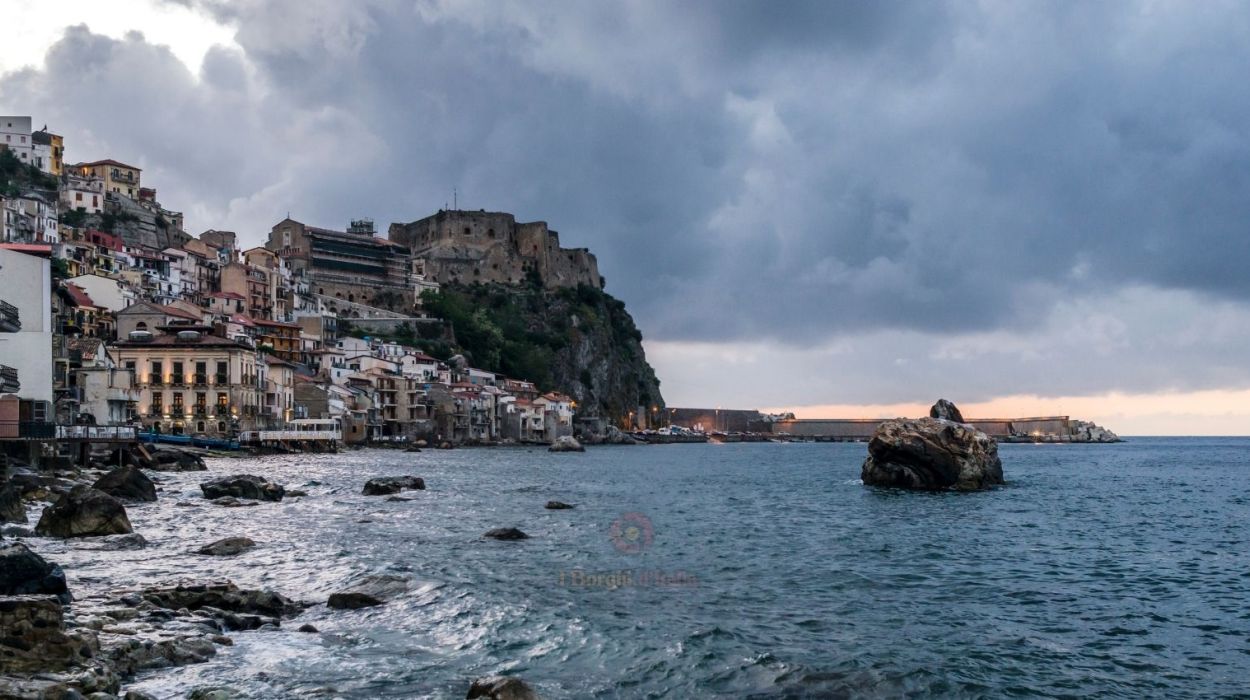
Il Borgo d’Italia
tutto da scoprire ed esplorare
Monumenti
L’Eterno Scenario di Scilla: Dove il Mito è Architettura
Scilla è un borgo che sfida il tempo e il mare, e i suoi monumenti non sono semplici strutture, ma sentinelle di pietra che raccontano una storia millenaria. Dalla rocca che domina lo Stretto ai quartieri che si tuffano nell’acqua, ogni pietra qui è intrisa di mito, strategia e fede.
1. Il Castello Ruffo: La Fortezza tra Storia e Leggenda
Il Castello Ruffo di Scilla è senza dubbio il simbolo iconico del borgo, un’imponente fortezza che sorge su uno sperone roccioso a picco sul mare. È il luogo dove il mito omerico di Scilla si materializza.
- Stratificazione Storica: Le sue origini affondano nella Magna Grecia e furono i Normanni a trasformarlo in una rocca militare nel Medioevo. Nel XV secolo passò alla potente famiglia Ruffo di Calabria, che lo convertì in una maestosa residenza feudale, arricchendolo con saloni degni di una delle casate più importanti del Regno di Napoli.
- Ruolo Strategico e Moderno: La sua posizione era cruciale per la difesa e l’avvistamento, tanto che ancora oggi ospita un faro della Marina Militare. Attualmente è un importante centro culturale che accoglie mostre e convegni, offrendo dai suoi ampi saloni e terrazze una vista panoramica senza eguali sullo Stretto di Messina, sul borgo di Chianalea e sulla Costa Viola.
2. Chianalea: Il Monumento al Vivere Marinaro
Se il castello è il monumento della storia, il quartiere di Chianalea è il monumento della vita, un capolavoro di architettura spontanea e marittima, conosciuto come la “Piccola Venezia del Sud”.
- Case-Palafitte: Questo antico quartiere di pescatori è caratterizzato da case costruite direttamente sulla roccia, con le fondamenta che lambiscono l’acqua. I vicoli stretti, che spesso terminano direttamente nel mare, conferiscono al luogo un fascino unico e romantico.
- Patrimonio Immateriale: Chianalea non è solo un complesso di edifici, ma il cuore pulsante della tradizione scillese, dove la cultura della pesca, con le tipiche lucìe ormeggiate sotto casa, si respira ancora in ogni angolo.
3. Le Chiese: Simboli di Fede e Resilienza
Nonostante i cataclismi sismici che hanno più volte colpito la zona, Scilla conserva importanti testimonianze della sua profonda fede.
- Chiesa dello Spirito Santo (Marina Grande): Questa chiesa cinquecentesca è nota per essere stata uno dei pochi edifici a resistere parzialmente ai violenti terremoti. Al suo interno custodisce pregevoli opere d’arte, tra cui un dipinto di Francesco Celebrano (La discesa dello Spirito Santo).
- Chiesa di San Rocco (San Giorgio): Dedicata al Santo Patrono di Scilla, questa chiesa si trova nell’omonima piazza. L’attuale struttura è il risultato di ricostruzioni successive ai sismi, ma è il cuore pulsante delle celebrazioni più sentite, culminanti con il famoso e coreografico “trionfino” durante la festa patronale.
4. Monumento al Mito di Scilla
Nella piazza principale, sul belvedere, un monumento moderno rende omaggio alle radici più antiche della città.
- Scultura Bronzea: L’opera, realizzata dall’artista reggino Francesco Triglia, celebra il Mito di Scilla e la sua metamorfosi da ninfa a mostro, ricordando ai visitatori che camminano su una terra intessuta di epica e meraviglia.
Visitare Scilla significa fare un viaggio attraverso millenni di storia, dove la grandezza del passato e la bellezza del presente si incontrano in un’unica, maestosa rocca.
Curiosità
Scilla: Curiosità che Trovano il Mito nel Quotidiano ✨
Scilla non è solo un borgo di straordinaria bellezza; è un luogo dove la realtà si fonde con le leggende millenarie, offrendo al visitatore curiosità uniche che ne cementano il fascino epico e marinaro. Dalla sua etimologia al modo di vivere dei suoi abitanti, ecco cosa rende Scilla un’esperienza indimenticabile.
1. La Vostra Doppia Identità Mitologica: Scilla e Cariddi
La curiosità più celebre è scolpita nel nome stesso della città. Scilla non è famosa solo per la sua bellezza, ma perché, nella mitologia greca, era la sede del terribile mostro marino a sei teste, Scilla, che terrorizzava i naviganti.
- Il Pericolo dello Stretto: Il borgo si trova proprio sulla sponda calabrese dello Stretto di Messina, di fronte a Cariddi (idealmente posizionata nella zona di Messina, in Sicilia). Le forti correnti che si creano in questo stretto tratto di mare hanno dato origine al detto “tra Scilla e Cariddi”, che significa trovarsi “tra l’incudine e il martello” o in una situazione di doppio e inevitabile pericolo.
- La Ninfa e la Magia: La leggenda narra che Scilla fosse in origine una bellissima ninfa dagli occhi azzurri, trasformata in mostro dalla maga Circe per gelosia, dopo che il dio marino Glauco si era innamorato di lei.
2. Il Colore e l’Etimologia: La Costa Viola
Scilla è il gioiello principale della Costa Viola, un tratto di litorale unico in Calabria.
- Il Fenomeno Ottico: Il nome “Costa Viola” deriva da uno spettacolo naturale che si manifesta al tramonto. In quel momento magico, i riflessi del sole che cala sull’acqua limpida e profonda dello Stretto colorano le scogliere e il mare di intense sfumature di viola, porpora e indaco.
- Platone e la Luce: Alcuni storici e mitografi attribuiscono la prima descrizione di questo fenomeno cromatico addirittura al filosofo greco Platone, che ne rimase incantato.
3. L’Architettura del Borgo dei Pescatori: Chianalea
Il quartiere di Chianalea, noto come la “Piccola Venezia del Sud”, custodisce una curiosità architettonica che ne definisce l’identità.
- Case Costruite sul Mare: La caratteristica distintiva di Chianalea è che le sue case sono edificate a ridosso degli scogli, con le fondamenta che lambiscono o addirittura sono dentro il mare. Questo creava un accesso diretto all’acqua per i pescatori, che potevano ormeggiare le loro piccole imbarcazioni (spesso la lucìa a remi) quasi sotto casa.
- Strade Acquatiche: Le strette vie del borgo sono più simili a canali che a strade vere e proprie, contribuendo al soprannome veneziano del quartiere.
4. Il Castello dei Ruffo: Non Solo Fortezza
Il maniero che domina Scilla, il Castello dei Ruffo, è un luogo di grande storia con una funzione inaspettata.
- Il Faro Sentinella: All’interno del Castello, che ha una storia che affonda le radici nella Magna Grecia, si trova un faro ancora attivo della Marina Militare. Questa struttura aggiunge un elemento pratico e moderno a una fortezza che ha visto succedersi Greci, Bizantini, Normanni e, infine, i Principi Ruffo.
5. La Caccia al Pescespada: Una Tradizione Epica
La pesca del Pescespada a Scilla e nell’area dello Stretto è stata per secoli un rito quasi sacro, con tecniche ancestrali.
- La Feluca: La pesca tradizionale avviene ancora oggi utilizzando la “Feluca”, una tipica imbarcazione dotata di un’altissima antenna centrale (antinna) per l’avvistamento e una lunga passerella (passerella) a prua per l’arpionamento. Questa caccia è un vero e proprio duello tra uomo e pesce, ed è stata immortalata in film e documentari, tra cui il celebre Lu tempu di li pisci spata (1954) di Vittorio De Seta.
Personaggi
L’Eredità di Scilla: Uomini di Scienza, Arte e Impegno Civile
Scilla, la città del mito, non è solo una meraviglia paesaggistica e un custode di leggende omeriche. Dai suoi vicoli di pescatori e dalla sua rocca maestosa, sono emerse personalità che hanno lasciato un segno indelebile nella storia, nella scienza e nell’arte. Scilla è stata la culla di una borghesia illuminata che, anche di fronte a tragedie epocali come il terremoto del 1783, ha saputo risollevarsi grazie al genio e all’impegno dei suoi figli più illustri.
Il Genio del Settecento: Scienziati, Medici e Incisori
Il Settecento fu un’età d’oro per la cultura scillese, che vide nascere figure di spicco con interessi che spaziavano dalla medicina all’astronomia.
Rocco Bova: L’Astronomo e Sindaco Illuminato
Nato nel 1743, Rocco Bova fu una figura poliedrica e fondamentale per il riscatto di Scilla.
- Scienza e Politica: Dopo aver conseguito la laurea in medicina a Bologna, si distinse per i suoi studi in fisica, botanica e, in particolare, astronomia. Il suo impegno, tuttavia, non si limitò alla scienza pura: tornato a Scilla dopo il catastrofico terremoto del 1783, ne divenne Sindaco nel 1798.
- Visione Civica: Rocco Bova lottò contro la feudalità del Castello Ruffo e fu il primo a presentare un progetto per la costruzione del porto di Scilla, dimostrando una visione moderna e un profondo attaccamento al benessere della sua comunità.
Mariano Bova: L’Artista dell’Incisione
Fratello minore di Rocco, Mariano Bova (nato nel 1757) portò il talento scillese nel mondo dell’arte.
- Maestro Incisore: Dopo gli studi di disegno e scultura a Napoli, si perfezionò a Londra nell’arte dell’incisione. La sua opera è cruciale per la documentazione visiva dell’epoca, avendo illustrato con meticolosa precisione molte vedute della Calabria e di Scilla stessa, collaborando con lo studioso domenicano Padre Antonio Minasi. Il suo lavoro artistico contribuì a diffondere l’immagine e la storia del suo territorio ben oltre i confini regionali.
Giuseppe Bova: Medico e Fondatore
Contemporaneo di Rocco e Mariano, Giuseppe Bova (nato nel 1697) fu un sacerdote e medico di grande fama. Studiò a Firenze e si laureò a Bologna, per poi tornare a Scilla dove fondò una scuola di medicina, istruendo numerosi concittadini e contribuendo a innalzare il livello culturale e scientifico del borgo. La sua vita terminò tragicamente durante il terremoto del 1783.
Diego Andrea Tomacelli: Il Vescovo Dotto
Sempre nel Settecento, Scilla diede i natali a Diego Andrea Tomacelli (nato nel 1697). Uomo di profonda cultura e straordinaria erudizione nelle scienze e nelle lingue, perfezionò i suoi studi a Roma in discipline sacre e lingue orientali, arrivando a occupare l’importante sede vescovile di Marsico Nuovo.
Queste figure non sono solo nomi su una lapide, ma rappresentano la forza intellettuale e la resilienza di Scilla, dimostrando che il suo fascino non risiede solo nel mito, ma anche nella capacità di generare eccellenze capaci di influenzare la storia locale e nazionale.
Ricette Tipiche
Il Gusto Epico di Scilla: Quando il Mare Incontra la Calabria Piccante
La gastronomia di Scilla è il riflesso fedele del suo paesaggio: audace, legata al mare e intrisa dei sapori intensi della terra calabrese. Le ricette tipiche di questo borgo, sospeso tra il mito di Scilla e Cariddi e le onde della Costa Viola, celebrano un unico, incontrastato protagonista: il Pescespada.
Il Protagonista Indiscusso: Il Pescespada
Scilla è da sempre uno dei centri nevralgici della pesca tradizionale del pesce spada nello Stretto di Messina, un’attività che è storia, rito e, naturalmente, ingrediente principe della cucina locale.
1. Il Panino con il Pescespada: Lo Street Food Iconico
Quella che in apparenza sembra una preparazione semplice, è in realtà un’esplosione di sapori che è diventata lo street food simbolo di Scilla e della vicina Chianalea.
- La Quintessenza del Sapore: Il panino è farcito con una spessa fetta di Pescespada sapientemente grigliata. La magia risiede nel condimento: il tradizionale Salmoriglio, un’emulsione semplice ma aromatica a base di olio extra vergine d’oliva, succo di limone fresco, aglio tritato finemente e origano.
- Le Varianti Locali: Non mancano aggiunte come cipolle rosse di Tropea caramellate, pomodorini freschi o una spolverata di granella di pistacchio, che esaltano la delicatezza della carne di spada in un connubio irresistibile.
2. Involtini di Pescespada alla Scillese
Un classico della cucina di mare calabrese che non può mancare sulle tavole di Scilla, spesso preparato con un ripieno ricco e saporito.
- Il Ripieno Fragrante: Sottili fette di pesce spada vengono arrotolate attorno a un ripieno che varia leggermente, ma include tipicamente pan grattato, capperi, olive verdi, prezzemolo, e talvolta piccoli pezzetti di pomodoro e un pizzico di peperoncino rosso per un tocco piccante.
- Cottura a Piacere: Gli involtini possono essere semplicemente cotti al forno, grigliati o immersi in un leggero sugo di pomodoro, sprigionando un profumo mediterraneo inconfondibile.
Oltre lo Spada: La Tradizione del Territorio
Sebbene il pesce spada regni sovrano, la cucina di Scilla attinge pienamente alla ricchezza agroalimentare calabrese.
3. Pesce Spada a’ Gghiotta (alla Ghiotta)
Questo è il piatto che unisce la costa calabrese e quella siciliana, celebrando il pesce in una cottura ricca e saporita, perfetta per condire anche la pasta.
- Il Sugo Avvolgente: Le fette di pesce spada vengono cotte in umido con un sugo denso a base di cipolla, polpa di pomodoro, olive verdi o nere, abbondanti capperi e sedano. L’aggiunta di una patata a pezzi conferisce al sugo una consistenza unica, rendendolo ideale per la scarpetta finale.
4. Prelibatezze “Arriganate”
Tipiche di tutta l’area dello Stretto, le alici o altri piccoli pesci vengono preparati arriganati, ovvero cotti (o marinati) con abbondante origano e un tocco di peperoncino. Un esempio di quanto i sapori semplici della terra esaltino il pescato fresco.
La cucina di Scilla è un invito a gustare il Mediterraneo in tutta la sua forza: sapori netti, decisi, che raccontano la vita intensa di un borgo marinaro dove la storia e il gusto si incontrano sulla scogliera.
